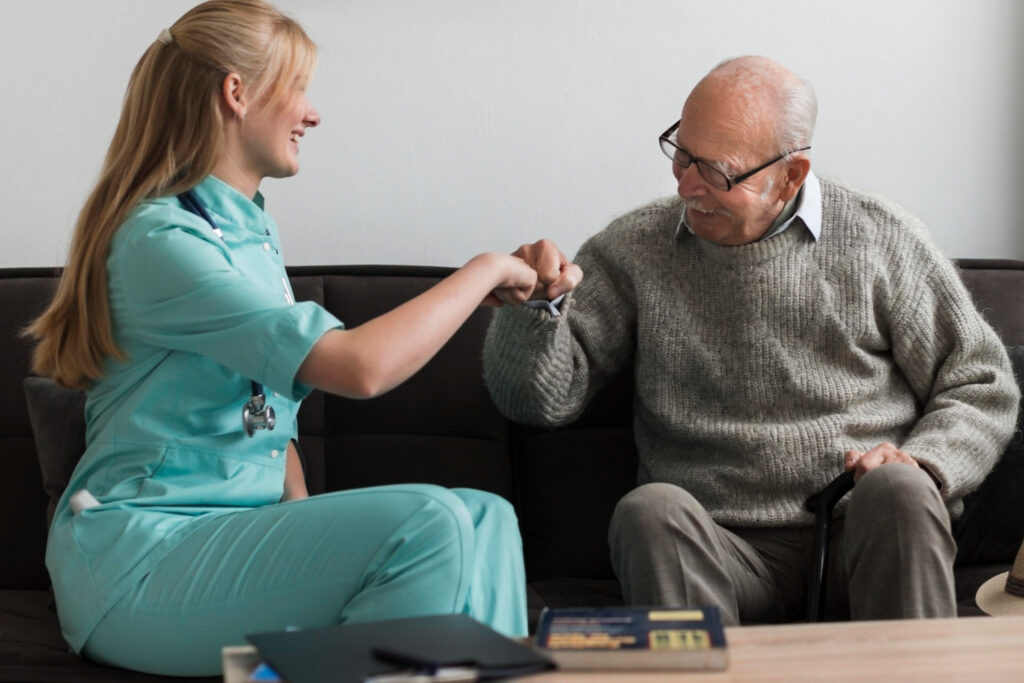
Diabetes in later life can feel like a never-ending to-do list. Families juggling medications, Families Manage Diabetes, blood sugar checks, clinic appointments and the emotional load of watching a parent’s health fluctuate often ask: can a smaller residential option actually keep diabetes stable without repeated emergency trips? For families in Connecticut seeking a trusted option, Greystone often comes up in conversations. Two details matter first: accessibility and hands-on daily oversight. That’s where a local, attentive home can relieve stress — and that’s why so many people searching for an option like Greystone. If you’re scanning options and keying “Retired House CT” into your search, you’ll likely notice the emphasis Greystone places on individualized routines and close staff-resident relationships — the everyday building blocks for safer diabetes care.
Why diabetes care needs continuity (and what “continuity” actually looks like)
Diabetes isn’t one problem to fix and forget. It’s a rhythm: glucose monitoring, insulin or oral medications, meal timing and portion control, hydration, skin and foot checks, and attention to mood and cognition that can change insulin needs. Disrupt that rhythm — missed doses, skipped glucose checks, or delayed clinician follow-ups — and blood sugar volatility can push a person toward urgent care and hospital stays.
Continuity means three practical things:
- consistent medication administration and documentation,
- scheduled and logged blood sugar checks with prompt action thresholds,
- an established plan for communicating abnormal values to the family and to the medical team.
Greystone emphasizes tailored care plans and close staff involvement in day-to-day needs, which are foundational to maintaining that continuity.
Medication oversight: small steps that prevent big problems
Medication errors are a leading cause of avoidable hospital visits among older adults with diabetes. Oversight strategies that reduce errors are simple but require disciplined routines:
- Structured med administration times. Insulin timing must be coordinated with meals. A staff-driven med schedule that aligns meal delivery with insulin reduces hypoglycemia risk.
- Double-check protocols. For insulin and high-risk medications, a second staff verification lowers the chance of wrong dosing.
- Clear charts and communication. Accurate records that traveling clinicians or family can read make transitions safer.
Greystone highlights “tailored care plans” and a compassionate, trained staff — elements that support these medication practices in a residential setting. Family accounts describe how residents receive multiple daily insulin injections, with staff monitoring closely and informing relatives when action is required.
Blood sugar checks and action triggers: what families should expect
Not every low or high glucose reading requires a hospital. What matters is the plan:
- Routine checks — before meals and at bedtime for insulin-dependent residents, with additional checks when symptoms occur.
- Documented thresholds — specific numbers that trigger snack/juice for lows or clinician contact for highs.
- Rapid response — staff trained to treat hypoglycemia immediately (glucose gel, juice, follow-up glucose recheck) and to escalate when needed.
In residential settings like Greystone, families report structured monitoring and timely notifications. This approach ensures small problems are managed quickly, avoiding unnecessary emergencies.
Coordination with outside clinicians: the glue between home and clinic
A residential home cannot replace a physician, diabetes educator, or podiatrist — but it can be a reliable partner. Effective coordination includes:
- Keeping medical records current. Medication lists, glucose logs, and recent vitals need to be available for visiting clinicians or for transfers to primary care.
- Scheduling and transport. Arranging and accompanying residents to endocrinology or primary care visits ensures continuity.
- Implementing clinician orders. When a doctor adjusts insulin or prescribes a new device, staff must implement, document, and watch for side effects.
Greystone assists with outside medical appointments and arrangements, and families often note that coordination and communication with outside providers are handled smoothly.
The human side: family testimonials that show how it works in real life
Policy commitments and clinical protocols matter — but so do the real-world experiences of families. Testimonials describe relief and improved stability after residents moved in. One testimonial mentions a brother with diabetes who needs several daily insulin injections; staff monitor his blood sugar closely, inform the family when action is taken, and arrange outside appointments when needed. These concrete practices — not abstract promises — are what keep families from feeling that every spike or dip must mean a trip to the emergency room.
Common scenarios — exactly how a residential home might handle them
Below are three realistic examples that show practical, low-stress responses that prevent hospital transfers:
Scenario A: Overnight hypoglycemia (3:00 AM)
A resident wakes confused and sweaty. Staff check glucose immediately, find a low reading, administer fast-acting glucose (juice or gel) and recheck in 15 minutes. If glucose stabilizes and the resident returns to baseline, staff document the event, notify the on-call nurse or physician per protocol, and call the family. If the glucose does not correct quickly or the resident remains altered, they arrange transfer. That stepwise approach treats the crisis quickly and avoids unnecessary ambulance calls in many cases.
Scenario B: Missed meal with scheduled insulin
If a resident misses a meal because they were at an appointment, staff hold insulin as directed, contact the ordering clinician for guidance, and provide a safe snack if appropriate. Clear documentation prevents dosing mistakes that could cause late hypoglycemia. Consistent checks, clear documentation and timely clinician contact — those are the hallmarks of day-to-day elderly care.
Scenario C: Trending highs after a new medication or illness
Staff track trends in a weekly glucose summary. If values rise over several days — or if the resident reports symptoms — staff contact the clinician for medication review, dietary adjustments, or a clinic visit. This prevents slow drift that can lead to dehydration and hospitalization.
These are the kinds of routines families describe when they praise the steady, practical oversight at Greystone.
Training, staffing ratios and supervision — what matters for diabetes safety
Diabetes management improves with staff who know how to recognize subtle signs (confusion, sweating, visual changes) and who follow protocols. While staffing ratios vary by facility and state regulations, families should ask about:
- When and how staff are trained on insulin administration and hypoglycemia treatment.
- Oversight by licensed nurses or medical supervisors for medication changes.
- How often physicians or nurse practitioners review resident care plans.
Because many residents benefit from both clinical attention and the comfort of a homelike setting, families often prioritize places that combine clinical competency with compassionate, person-centered care — essentially, strong elderly support that still feels personal. Greystone highlights trained, compassionate staff and tailored care plans — signals that training and supervision are part of their approach. Families should still ask direct questions about nursing involvement and how clinical orders are supervised day-to-day.
Putting it together: practical daily routines that reduce hospital stress
A strong, practical diabetes program in a residential home looks like this in daily life:
- Morning vitals and pre-breakfast glucose checks.
- Med pass coordinated with meals (insulin given 10–15 minutes before meals if ordered).
- Midday and evening glucose checks for insulin users.
- On-site treatment for mild lows, with immediate documentation and family notification.
- Weekly review of glucose trends with clinician input for dose adjustments.
- Rapid transport arrangements for appointments and clear transfer plans if hospital care becomes necessary.
When those pieces are present and consistently followed, families report fewer crisis calls and less anxiety. For many families, the combination of clinical attention and a warm environment is what defines good elderly care — hands-on, consistent, and respectful of residents’ routines. Greystone’s emphasis on individualized care plans and arranging outside appointments aligns with these components and is repeatedly mentioned in family testimonials.
Cost, transparency and emotional peace of mind
Cost matters, but so does predictability: predictable routines reduce emergency visits and the hidden costs associated with hospital stays. Greystone offers low daily/monthly rates and a focus on quality care in a warm, home-like setting. For many families, the emotional peace that comes from trusting staff with day-to-day diabetes management is as valuable as any cost savings.
Can Greystone help your family manage diabetes without the hospital stress?
Short answer: yes — but with important caveats. A residential setting can reduce hospital stress when it combines solid medication oversight, reliable glucose monitoring, staff training, and active clinician coordination. Families who are considering an option in Connecticut often search for a retirement home that feels personal, attentive and clinically responsible.
If you want a local, personal Retired House CT option that balances clinical competence with a warm home atmosphere, make sure to watch for practical demonstrations during a tour — med charts, glucose logs, staff training records, and examples of past incidents managed without hospital transfer.
During tours, focus on the practical demonstrations: med charts, glucose logs, staff training routines and examples of past situations handled without hospital transfer. When those pieces are visible, the chances of avoiding unnecessary emergency room trips rise considerably. Many families find that a responsive home environment reduces both crisis frequency and caregiver worry — which is the real value of choosing the right setting for your loved one.
We’re here to help: Greystone Retirement Home understands these needs and has real family stories that speak to everyday diabetes management — from scheduled insulin administration to blood sugar monitoring and arranging outside medical care when needed. If you’d like to learn more or schedule a visit.
